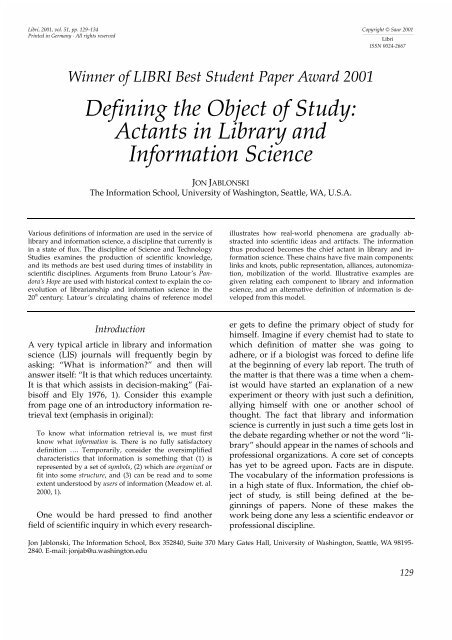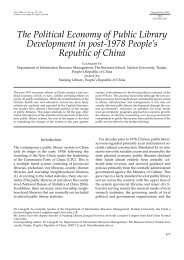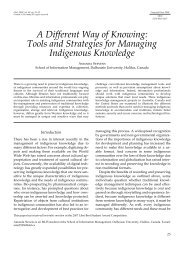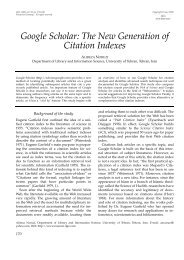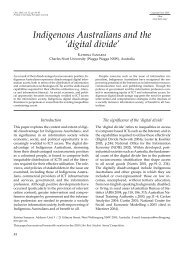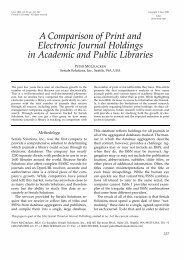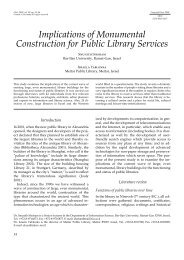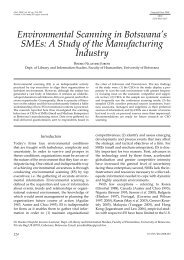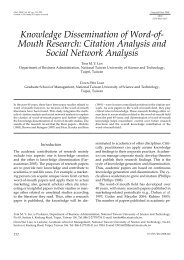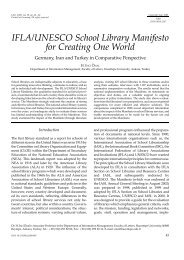Defining the object of study: actants in Library and Information ... - Libri
Defining the object of study: actants in Library and Information ... - Libri
Defining the object of study: actants in Library and Information ... - Libri
You also want an ePaper? Increase the reach of your titles
YUMPU automatically turns print PDFs into web optimized ePapers that Google loves.
<strong>Libri</strong>, 2001, vol. 51, pp. 129–134<br />
Pr<strong>in</strong>ted <strong>in</strong> Germany · All rights reserved<br />
Copyright © Saur 2001<br />
___________________________________________<br />
<strong>Libri</strong><br />
ISSN 0024-2667<br />
W<strong>in</strong>ner <strong>of</strong> LIBRI Best Student Paper Award 2001<br />
<strong>Def<strong>in</strong><strong>in</strong>g</strong> <strong>the</strong> Object <strong>of</strong> Study:<br />
Actants <strong>in</strong> <strong>Library</strong> <strong>and</strong><br />
<strong>Information</strong> Science<br />
JON JABLONSKI<br />
The <strong>Information</strong> School, University <strong>of</strong> Wash<strong>in</strong>gton, Seattle, WA, U.S.A.<br />
Various def<strong>in</strong>itions <strong>of</strong> <strong>in</strong>formation are used <strong>in</strong> <strong>the</strong> service <strong>of</strong><br />
library <strong>and</strong> <strong>in</strong>formation science, a discipl<strong>in</strong>e that currently is<br />
<strong>in</strong> a state <strong>of</strong> flux. The discipl<strong>in</strong>e <strong>of</strong> Science <strong>and</strong> Technology<br />
Studies exam<strong>in</strong>es <strong>the</strong> production <strong>of</strong> scientific knowledge,<br />
<strong>and</strong> its methods are best used dur<strong>in</strong>g times <strong>of</strong> <strong>in</strong>stability <strong>in</strong><br />
scientific discipl<strong>in</strong>es. Arguments from Bruno Latour’s P<strong>and</strong>ora’s<br />
Hope are used with historical context to expla<strong>in</strong> <strong>the</strong> coevolution<br />
<strong>of</strong> librarianship <strong>and</strong> <strong>in</strong>formation science <strong>in</strong> <strong>the</strong><br />
20 th century. Latour’s circulat<strong>in</strong>g cha<strong>in</strong>s <strong>of</strong> reference model<br />
illustrates how real-world phenomena are gradually abstracted<br />
<strong>in</strong>to scientific ideas <strong>and</strong> artifacts. The <strong>in</strong>formation<br />
thus produced becomes <strong>the</strong> chief actant <strong>in</strong> library <strong>and</strong> <strong>in</strong>formation<br />
science. These cha<strong>in</strong>s have five ma<strong>in</strong> components:<br />
l<strong>in</strong>ks <strong>and</strong> knots, public representation, alliances, autonomization,<br />
mobilization <strong>of</strong> <strong>the</strong> world. Illustrative examples are<br />
given relat<strong>in</strong>g each component to library <strong>and</strong> <strong>in</strong>formation<br />
science, <strong>and</strong> an alternative def<strong>in</strong>ition <strong>of</strong> <strong>in</strong>formation is developed<br />
from this model.<br />
Introduction<br />
A very typical article <strong>in</strong> library <strong>and</strong> <strong>in</strong>formation<br />
science (LIS) journals will frequently beg<strong>in</strong> by<br />
ask<strong>in</strong>g: “What is <strong>in</strong>formation” <strong>and</strong> <strong>the</strong>n will<br />
answer itself: “It is that which reduces uncerta<strong>in</strong>ty.<br />
It is that which assists <strong>in</strong> decision-mak<strong>in</strong>g” (Faibis<strong>of</strong>f<br />
<strong>and</strong> Ely 1976, 1). Consider this example<br />
from page one <strong>of</strong> an <strong>in</strong>troductory <strong>in</strong>formation retrieval<br />
text (emphasis <strong>in</strong> orig<strong>in</strong>al):<br />
To know what <strong>in</strong>formation retrieval is, we must first<br />
know what <strong>in</strong>formation is. There is no fully satisfactory<br />
def<strong>in</strong>ition …. Temporarily, consider <strong>the</strong> oversimplified<br />
characteristics that <strong>in</strong>formation is someth<strong>in</strong>g that (1) is<br />
represented by a set <strong>of</strong> symbols, (2) which are organized or<br />
fit <strong>in</strong>to some structure, <strong>and</strong> (3) can be read <strong>and</strong> to some<br />
extent understood by users <strong>of</strong> <strong>in</strong>formation (Meadow et. al.<br />
2000, 1).<br />
One would be hard pressed to f<strong>in</strong>d ano<strong>the</strong>r<br />
field <strong>of</strong> scientific <strong>in</strong>quiry <strong>in</strong> which every researcher<br />
gets to def<strong>in</strong>e <strong>the</strong> primary <strong>object</strong> <strong>of</strong> <strong>study</strong> for<br />
himself. Imag<strong>in</strong>e if every chemist had to state to<br />
which def<strong>in</strong>ition <strong>of</strong> matter she was go<strong>in</strong>g to<br />
adhere, or if a biologist was forced to def<strong>in</strong>e life<br />
at <strong>the</strong> beg<strong>in</strong>n<strong>in</strong>g <strong>of</strong> every lab report. The truth <strong>of</strong><br />
<strong>the</strong> matter is that <strong>the</strong>re was a time when a chemist<br />
would have started an explanation <strong>of</strong> a new<br />
experiment or <strong>the</strong>ory with just such a def<strong>in</strong>ition,<br />
ally<strong>in</strong>g himself with one or ano<strong>the</strong>r school <strong>of</strong><br />
thought. The fact that library <strong>and</strong> <strong>in</strong>formation<br />
science is currently <strong>in</strong> just such a time gets lost <strong>in</strong><br />
<strong>the</strong> debate regard<strong>in</strong>g whe<strong>the</strong>r or not <strong>the</strong> word “library”<br />
should appear <strong>in</strong> <strong>the</strong> names <strong>of</strong> schools <strong>and</strong><br />
pr<strong>of</strong>essional organizations. A core set <strong>of</strong> concepts<br />
has yet to be agreed upon. Facts are <strong>in</strong> dispute.<br />
The vocabulary <strong>of</strong> <strong>the</strong> <strong>in</strong>formation pr<strong>of</strong>essions is<br />
<strong>in</strong> a high state <strong>of</strong> flux. <strong>Information</strong>, <strong>the</strong> chief <strong>object</strong><br />
<strong>of</strong> <strong>study</strong>, is still be<strong>in</strong>g def<strong>in</strong>ed at <strong>the</strong> beg<strong>in</strong>n<strong>in</strong>gs<br />
<strong>of</strong> papers. None <strong>of</strong> <strong>the</strong>se makes <strong>the</strong><br />
work be<strong>in</strong>g done any less a scientific endeavor or<br />
pr<strong>of</strong>essional discipl<strong>in</strong>e.<br />
Jon Jablonski, The <strong>Information</strong> School, Box 352840, Suite 370 Mary Gates Hall, University <strong>of</strong> Wash<strong>in</strong>gton, Seattle, WA 98195-<br />
2840. E-mail: jonjab@u.wash<strong>in</strong>gton.edu<br />
129
Jon Jablonski<br />
Science <strong>and</strong> Technology Studies (STS) practitioners<br />
would argue that LIS is a prime target<br />
for <strong>the</strong>ir <strong>in</strong>quiries precisely because nearly everyth<strong>in</strong>g<br />
that happens <strong>in</strong> contemporary librarianship<br />
<strong>and</strong> <strong>in</strong>formation science happens ‘on <strong>the</strong> edge’ –<br />
what Jay Lab<strong>in</strong>ger calls “frontier science” (Lab<strong>in</strong>ger<br />
1997, 214). Thomas Kuhn would consider<br />
<strong>the</strong>se times <strong>of</strong> shift<strong>in</strong>g paradigms (Kuhn 1962).<br />
Part <strong>of</strong> this is a function <strong>of</strong> be<strong>in</strong>g an extremely<br />
new science. Librarianship did not take on <strong>the</strong><br />
moniker <strong>and</strong> methodologies <strong>of</strong> science before <strong>the</strong><br />
Carnegie Foundation funded <strong>the</strong> University <strong>of</strong><br />
Chicago’s Graduate <strong>Library</strong> School, whose faculty<br />
was made up primarily <strong>of</strong> social scientists – not<br />
librarians (Harris 1995, 292). The term <strong>in</strong>formation<br />
science only supplanted documentation <strong>in</strong><br />
<strong>the</strong> early 1960s, <strong>and</strong> not <strong>of</strong>ficially until 1968, with<br />
<strong>the</strong> American Documentation Institute chang<strong>in</strong>g<br />
its name to <strong>the</strong> American Society for <strong>Information</strong><br />
Science (Lilley <strong>and</strong> Trice 1989).<br />
If only Melvil Dewey had voiced an op<strong>in</strong>ion<br />
regard<strong>in</strong>g his “mechanical art” (Harris 1995, 291)<br />
becom<strong>in</strong>g a science before his death <strong>in</strong> 1931 – ten<br />
years after <strong>the</strong> found<strong>in</strong>g <strong>of</strong> <strong>the</strong> Graduate <strong>Library</strong><br />
School. Likewise, how closely Norbert Wiener <strong>and</strong><br />
Vannevar Bush identified <strong>the</strong>mselves with librarians<br />
must forever be a matter <strong>of</strong> speculation. How<br />
current practitioners align <strong>the</strong>mselves can perhaps<br />
be determ<strong>in</strong>ed by us<strong>in</strong>g <strong>the</strong> methods <strong>of</strong> STS.<br />
The debate regard<strong>in</strong>g what to call ourselves<br />
should be viewed <strong>in</strong> <strong>the</strong> light <strong>of</strong> <strong>the</strong>se complementary,<br />
but frequently compet<strong>in</strong>g, recent histories.<br />
With<strong>in</strong> <strong>the</strong>se contexts, <strong>in</strong>formation scientists <strong>and</strong><br />
librarians are work<strong>in</strong>g to stabilize a core set <strong>of</strong><br />
concepts, evolv<strong>in</strong>g criteria by which to judge <strong>the</strong><br />
quality <strong>of</strong> research, <strong>and</strong> even more basically, decid<strong>in</strong>g<br />
on appropriate topics for research <strong>and</strong> development.<br />
STS does most <strong>of</strong> its work on this<br />
type <strong>of</strong> frontier precisely because <strong>of</strong> this high rate<br />
<strong>of</strong> change: <strong>study</strong><strong>in</strong>g <strong>the</strong> evolution <strong>of</strong> knowledge<br />
dur<strong>in</strong>g times <strong>of</strong> great change is much more <strong>in</strong>terest<strong>in</strong>g<br />
than <strong>study</strong><strong>in</strong>g it dur<strong>in</strong>g times <strong>of</strong> stasis.<br />
Certa<strong>in</strong>ly, research ‘on <strong>the</strong> edge’ <strong>of</strong> knowledge is<br />
also where scientists are most <strong>of</strong>ten wrong, but<br />
<strong>the</strong> job <strong>of</strong> STS is to comment on <strong>the</strong> process <strong>of</strong><br />
science – not <strong>the</strong> validity <strong>of</strong> <strong>in</strong>dividual results.<br />
Science <strong>and</strong> technology studies<br />
STS’s earliest work was by fem<strong>in</strong>ist anthropologists<br />
cast<strong>in</strong>g a critical eye toward <strong>the</strong> practice <strong>of</strong><br />
anthropology (Frankl<strong>in</strong> 1995, 169). Sociologists<br />
<strong>and</strong> anthropologists <strong>the</strong>n turned this technique<br />
toward <strong>the</strong> observation <strong>of</strong> natural scientists <strong>in</strong><br />
<strong>the</strong>ir natural habitats: <strong>in</strong> labs <strong>and</strong> <strong>in</strong> <strong>the</strong> field. Historians<br />
<strong>of</strong> science, philosophers, cultural <strong>the</strong>orists,<br />
<strong>and</strong> literary critics have also come to embrace<br />
some <strong>of</strong> <strong>the</strong>se methods, search<strong>in</strong>g for science’s<br />
<strong>in</strong>fluence on society at large, <strong>and</strong> vice versa. Along<br />
<strong>the</strong> way, controversy has arisen as some scientists<br />
have revolted aga<strong>in</strong>st be<strong>in</strong>g treated as lab rats by<br />
those with no scientific credentials, <strong>and</strong> o<strong>the</strong>rs<br />
have ridiculed <strong>the</strong> whole exercise as “merely<br />
<strong>in</strong>comprehensible language masquerad<strong>in</strong>g as<br />
knowledge” (Fujimura 1998, 348).<br />
These controversies have become known collectively<br />
as <strong>the</strong> Science Wars, <strong>and</strong> have been characterized<br />
not so much by <strong>in</strong>dividual battles as by<br />
<strong>in</strong>dividual characters <strong>and</strong> emerg<strong>in</strong>g bodies <strong>of</strong><br />
scholarship. Card-carry<strong>in</strong>g scientists turned literary<br />
<strong>the</strong>orists <strong>and</strong> cultural critics (Donna Haraway,<br />
Ca<strong>the</strong>r<strong>in</strong>e Hayles <strong>and</strong> Andrew Picker<strong>in</strong>g, to<br />
name only three <strong>of</strong> <strong>the</strong> most visible) have opened<br />
up whole new fields <strong>of</strong> <strong>in</strong>quiry. Along <strong>the</strong> way,<br />
nearly forgotten fields such as textual studies <strong>and</strong><br />
analytical bibliography seem to have received<br />
new leases on life.<br />
Circulat<strong>in</strong>g cha<strong>in</strong>s <strong>of</strong> reference<br />
Ra<strong>the</strong>r than add<strong>in</strong>g to <strong>the</strong> Science War chronicles,<br />
I would like to apply two key models from Bruno<br />
Latour’s P<strong>and</strong>ora’s Hope – which exhaustively defends<br />
<strong>the</strong> work <strong>of</strong> science studies by giv<strong>in</strong>g it a<br />
thorough ground<strong>in</strong>g <strong>in</strong> epistemology, phenomenology,<br />
<strong>and</strong> semiotics [1] – <strong>and</strong> apply <strong>the</strong>m to<br />
librarianship <strong>and</strong> <strong>in</strong>formation science <strong>in</strong> an effort<br />
to decide if <strong>the</strong>se are separate pursuits, or two<br />
aspects <strong>of</strong> <strong>the</strong> same discipl<strong>in</strong>e.<br />
The first model is that <strong>of</strong> circulat<strong>in</strong>g cha<strong>in</strong>s <strong>of</strong><br />
reference. This should be <strong>of</strong> <strong>in</strong>terest to librarians,<br />
if not just for its oxymoronic name, <strong>the</strong>n because<br />
much <strong>of</strong> <strong>the</strong> <strong>in</strong>formation enterprise revolves<br />
around manag<strong>in</strong>g <strong>the</strong> last l<strong>in</strong>ks <strong>of</strong> all <strong>the</strong> sciences’<br />
<strong>and</strong> humanities’ cha<strong>in</strong>s – <strong>the</strong> journal articles,<br />
conference proceed<strong>in</strong>gs, <strong>and</strong> monographs<br />
that are <strong>the</strong> end result <strong>of</strong> field work, laboratory<br />
experiments, scholarly studies, <strong>and</strong> creative endeavors.<br />
These products are <strong>in</strong>timately familiar<br />
to librarians, <strong>in</strong>dexers, <strong>and</strong> developers <strong>of</strong> retrieval<br />
systems – so familiar that <strong>the</strong>y are frequently<br />
mistaken as be<strong>in</strong>g <strong>in</strong> <strong>the</strong> doma<strong>in</strong> <strong>of</strong> <strong>the</strong> <strong>in</strong>forma-<br />
130
<strong>Def<strong>in</strong><strong>in</strong>g</strong> <strong>the</strong> Object <strong>of</strong> Study<br />
tion pr<strong>of</strong>essions, when <strong>the</strong>y, <strong>in</strong> reality, are only<br />
charged with ensur<strong>in</strong>g <strong>the</strong> safekeep<strong>in</strong>g <strong>and</strong> ready<br />
access <strong>of</strong> <strong>the</strong>se products.<br />
At <strong>the</strong> opposite end <strong>of</strong> <strong>the</strong> cha<strong>in</strong> <strong>of</strong> reference,<br />
for <strong>the</strong> sciences at least, <strong>the</strong> first l<strong>in</strong>k is some<br />
measurement <strong>of</strong> an <strong>object</strong> <strong>in</strong> <strong>the</strong> world. For Latour,<br />
this measurement is <strong>the</strong> translation <strong>of</strong> a fact,<br />
through some sort <strong>of</strong> an <strong>in</strong>strument, <strong>in</strong>to a word<br />
or a number. As <strong>the</strong> world slowly moves onto <strong>the</strong><br />
shelves <strong>of</strong> libraries, “<strong>the</strong>re is ... a complete rupture<br />
at each stage between <strong>the</strong> ‘th<strong>in</strong>g’ part <strong>of</strong> each<br />
<strong>object</strong> <strong>and</strong> its ‘sign’ part” (Latour 1999, 60). Latour<br />
spends an entire chapter trac<strong>in</strong>g this cha<strong>in</strong>: a<br />
botanist, a pedologist (a soil scientist), a geologist<br />
<strong>and</strong> a sociologist (Latour himself) exam<strong>in</strong>e <strong>the</strong><br />
junction between a savanna by lay<strong>in</strong>g on a map<br />
on a table <strong>in</strong> a restaurant <strong>in</strong> South America; <strong>the</strong><br />
map’s graticule is <strong>the</strong>n transposed onto <strong>the</strong> l<strong>and</strong>scape<br />
by pound<strong>in</strong>g stakes <strong>in</strong>to <strong>the</strong> ground at <strong>the</strong><br />
po<strong>in</strong>ts <strong>of</strong> <strong>the</strong> grid, found by measur<strong>in</strong>g <strong>the</strong> distance<br />
from previously surveyed trees, soil samples<br />
are taken at po<strong>in</strong>ts along <strong>the</strong> grid, deposited<br />
<strong>in</strong>to a matrix <strong>of</strong> cubes (called a pedocomparator)<br />
that correspond to <strong>the</strong>ir orig<strong>in</strong>al locations, brought<br />
back to <strong>the</strong> restaurant tabletop for simple ‘tast<strong>in</strong>g’[2]<br />
<strong>and</strong> color analysis. F<strong>in</strong>ally conclusions are<br />
drawn, quite literally, <strong>in</strong> a journal article whose<br />
ma<strong>in</strong> illustration was produced on that same restaurant<br />
table where <strong>the</strong> story began.<br />
At each <strong>of</strong> <strong>the</strong>se stages, one ‘th<strong>in</strong>g’ st<strong>and</strong>s <strong>in</strong><br />
for ano<strong>the</strong>r. The diagram <strong>and</strong> text produced <strong>in</strong><br />
<strong>the</strong> above example bear little physical resemblance<br />
to <strong>the</strong> forest/savanna juncture, but by<br />
trac<strong>in</strong>g <strong>the</strong> orig<strong>in</strong> <strong>of</strong> each reference, one is able to<br />
move back toward <strong>the</strong> field <strong>and</strong> verify <strong>the</strong> scientists’<br />
conclusions.<br />
Like <strong>the</strong> footnotes used <strong>in</strong> scholarly works to which <strong>the</strong><br />
<strong>in</strong>quisitive or <strong>the</strong> skeptical ‘make reference’… this armful<br />
<strong>of</strong> specimens will guarantee <strong>the</strong> text that results from<br />
[<strong>the</strong>] field expedition. (Latour 1999, 34).<br />
These <strong>in</strong>quisitive <strong>and</strong> skeptical people use <strong>the</strong><br />
tools created by librarianship, <strong>the</strong> cha<strong>in</strong>s <strong>of</strong> reference<br />
<strong>of</strong> <strong>in</strong>formation science, to trace <strong>the</strong>se citations<br />
– backward cha<strong>in</strong><strong>in</strong>g <strong>in</strong> librarian-speak. A<br />
simple cha<strong>in</strong> <strong>of</strong> reference for a library is easy to<br />
articulate: a library decides what sorts <strong>of</strong> materials<br />
to collect based on <strong>the</strong> wishes <strong>of</strong> its constituencies;<br />
some sort <strong>of</strong> formal collection policy<br />
is established; classification schemes are picked<br />
so that topics can be explored via surrogates<br />
<strong>in</strong>stead <strong>of</strong> hav<strong>in</strong>g to navigate <strong>the</strong> source materials<br />
directly; a storage scheme is picked <strong>and</strong> (possibly)<br />
mapped onto a physical structure so that<br />
<strong>in</strong>dividual items can be found once <strong>the</strong>y are<br />
identified.<br />
A more generic <strong>in</strong>formation storage <strong>and</strong> retrieval<br />
system might be a little harder to underst<strong>and</strong><br />
<strong>in</strong> this way, but <strong>the</strong> basic purpose is <strong>the</strong><br />
same: to erase <strong>the</strong> boundaries between descriptions<br />
<strong>and</strong> <strong>the</strong> entities described. In an ideal system,<br />
we would<br />
never detect <strong>the</strong> rupture between th<strong>in</strong>gs <strong>and</strong> signs … We<br />
[would] see only an unbroken series <strong>of</strong> well-nested elements,<br />
each <strong>of</strong> which plays <strong>the</strong> role <strong>of</strong> sign for <strong>the</strong> previous<br />
one <strong>and</strong> <strong>of</strong> th<strong>in</strong>g for <strong>the</strong> succeed<strong>in</strong>g one (Latour 1999, 56).<br />
In fact, librarians do this so well that <strong>the</strong>y have<br />
started to compla<strong>in</strong> that users cannot tell <strong>the</strong><br />
difference between dist<strong>in</strong>ctly different resources.<br />
Each <strong>of</strong> <strong>the</strong>se elements can be called an actant,<br />
a term Latour borrows from semiotics. An actant<br />
is any participant <strong>in</strong> an endeavor, whe<strong>the</strong>r human<br />
or nonhuman. An actant is def<strong>in</strong>ed by what<br />
it does, <strong>in</strong> essence, what function it performs with<strong>in</strong><br />
a discipl<strong>in</strong>e. It emerges through trials (experiments,<br />
tradition, practical application), <strong>and</strong> once<br />
its fellows (usually human <strong>actants</strong> <strong>in</strong> <strong>the</strong> discipl<strong>in</strong>e)<br />
deem that it performs adequately (through<br />
a regularized process, such as peer review or<br />
commodification), it is admitted to an <strong>in</strong>stitution.<br />
The circulatory system <strong>of</strong> <strong>in</strong>formation science<br />
<strong>and</strong> librarianship<br />
The cha<strong>in</strong> <strong>of</strong> reference described above was said<br />
to circulate, <strong>and</strong> while reference materials do not<br />
ord<strong>in</strong>arily circulate, Bruno Latour’s do. In his<br />
circulatory system, <strong>actants</strong> move along five <strong>in</strong>tertw<strong>in</strong>ed<br />
loops: mobilization <strong>of</strong> <strong>the</strong> world, autonomization,<br />
alliances, public representation, <strong>and</strong><br />
l<strong>in</strong>ks or knots between <strong>the</strong>se loops.<br />
L<strong>in</strong>ks <strong>and</strong> knots<br />
L<strong>in</strong>ks <strong>and</strong> knots are perhaps <strong>the</strong> easiest part <strong>of</strong><br />
Latour’s circulatory system to underst<strong>and</strong>, even<br />
though he struggles not to def<strong>in</strong>e <strong>the</strong>m too precisely.<br />
These are connections between <strong>the</strong> o<strong>the</strong>r<br />
four loops, <strong>and</strong> <strong>the</strong>y exist to constantly feed <strong>the</strong><br />
131
Jon Jablonski<br />
whole system with <strong>the</strong> content <strong>of</strong> science – <strong>the</strong><br />
core concepts, practices, <strong>and</strong> <strong>in</strong>tellectual products<br />
<strong>of</strong> science live <strong>in</strong> <strong>the</strong>se knots. Without <strong>the</strong>se l<strong>in</strong>ks<br />
<strong>and</strong> knots, <strong>the</strong>re are no o<strong>the</strong>r loops, but at <strong>the</strong><br />
same time, without <strong>the</strong> o<strong>the</strong>r loops, <strong>the</strong> content <strong>of</strong><br />
science wi<strong>the</strong>rs away <strong>and</strong> dies.<br />
For <strong>in</strong>formation science, l<strong>in</strong>ks <strong>and</strong> knots <strong>in</strong>clude<br />
all those <strong>the</strong>ories <strong>and</strong> tools that are borrowed<br />
from o<strong>the</strong>r discipl<strong>in</strong>es: <strong>in</strong>formation behavior (simply<br />
ethnographic studies from anthropology), <strong>in</strong>formation<br />
transfer (communication <strong>the</strong>ory by<br />
any o<strong>the</strong>r name), systems <strong>the</strong>ory (from whatever<br />
circle <strong>of</strong> hell will claim it), <strong>and</strong> our complete misread<strong>in</strong>g<br />
<strong>of</strong> <strong>in</strong>formation <strong>the</strong>ory (from eng<strong>in</strong>eer<strong>in</strong>g<br />
<strong>and</strong> ma<strong>the</strong>matics).<br />
It was <strong>the</strong> comb<strong>in</strong>ation <strong>of</strong> <strong>the</strong>se methodological<br />
<strong>and</strong> <strong>the</strong>oretical <strong>actants</strong> that created a science<br />
from documentation studies. While <strong>the</strong> groundwork<br />
was laid by <strong>the</strong> social scientists at <strong>the</strong><br />
University <strong>of</strong> Chicago <strong>in</strong> <strong>the</strong> 1920s, it was <strong>the</strong> explosive<br />
growth <strong>of</strong> scientific <strong>in</strong>formation dur<strong>in</strong>g<br />
World War II that <strong>in</strong>spired eng<strong>in</strong>eers, chemists,<br />
<strong>and</strong> documentalists to <strong>in</strong>vent systems that could<br />
h<strong>and</strong>le <strong>the</strong> ever-<strong>in</strong>creas<strong>in</strong>g flow <strong>of</strong> scientific papers:<br />
selective dissem<strong>in</strong>ation <strong>of</strong> <strong>in</strong>formation<br />
(SDI), Keyword-<strong>in</strong>-Context <strong>and</strong> Keyword-out-<strong>of</strong>-<br />
Context mach<strong>in</strong>e <strong>in</strong>dex<strong>in</strong>g (KWIC/KWOC),<br />
Index Chemicus, <strong>and</strong> ERIC are all techniques <strong>and</strong><br />
systems that have <strong>the</strong>ir genesis outside <strong>of</strong> <strong>the</strong> library<br />
(Lilley 1989).<br />
Notice that no ‘native’ library science concepts<br />
were <strong>in</strong>cluded <strong>in</strong> <strong>the</strong> above discussion. At <strong>the</strong><br />
time, <strong>the</strong>se systems were be<strong>in</strong>g developed because<br />
Dewey’s traditional ‘library mach<strong>in</strong>e’ was<br />
be<strong>in</strong>g crushed under <strong>the</strong> weight <strong>of</strong> all <strong>the</strong> new<br />
<strong>in</strong>formation be<strong>in</strong>g produced. This period shows<br />
that librarians, up until this po<strong>in</strong>t, had simply<br />
been <strong>the</strong> pr<strong>of</strong>essional caretakers <strong>of</strong> <strong>in</strong>formation. It<br />
was <strong>the</strong> chemists, eng<strong>in</strong>eers, ma<strong>the</strong>maticians, <strong>and</strong><br />
cyberneticists who began to develop ways <strong>of</strong><br />
manag<strong>in</strong>g this new volume <strong>of</strong> <strong>in</strong>formation. That<br />
<strong>the</strong>se newly christened documentalists chose libraries<br />
<strong>and</strong> library schools as a home to conduct<br />
<strong>the</strong>ir research <strong>and</strong> ref<strong>in</strong>e <strong>the</strong>ir new techniques is<br />
perhaps a quirk <strong>of</strong> history – perhaps librarianship<br />
was simply <strong>the</strong> easiest doma<strong>in</strong> to conquer.<br />
Or perhaps librarianship looked at this rapidly<br />
evolv<strong>in</strong>g field <strong>and</strong> saw its ability to manipulate<br />
<strong>in</strong>formation <strong>in</strong> ways that are obviously good, <strong>and</strong><br />
saw its own reflection. It certa<strong>in</strong>ly adopted <strong>the</strong><br />
new tools <strong>and</strong> methods quickly enough.<br />
In this process, librarianship was taught to<br />
treat <strong>in</strong>formation as an <strong>in</strong>dependent actant, which<br />
not only dem<strong>and</strong>ed <strong>study</strong> (spawn<strong>in</strong>g <strong>in</strong>formation<br />
retrieval <strong>and</strong> <strong>the</strong> expansion <strong>of</strong> classification to<br />
<strong>in</strong>clude <strong>in</strong>dex<strong>in</strong>g, abstract<strong>in</strong>g, <strong>and</strong> a renewal <strong>of</strong> a<br />
philosophical look at knowledge organization),<br />
but also whose use dem<strong>and</strong>ed <strong>study</strong> (begett<strong>in</strong>g<br />
<strong>the</strong> <strong>study</strong> <strong>of</strong> <strong>in</strong>formation behavior). However, if<br />
<strong>in</strong>formation science now ab<strong>and</strong>ons libraries <strong>in</strong><br />
favor <strong>of</strong> treat<strong>in</strong>g <strong>in</strong>formation as a free float<strong>in</strong>g<br />
entity, divorced from any sort <strong>of</strong> bibliographic<br />
context, if all research <strong>and</strong> development efforts<br />
are put <strong>in</strong>to <strong>the</strong> market economy, if <strong>in</strong>formation<br />
science becomes a slave to private research dollars<br />
just because that is where is currently hav<strong>in</strong>g<br />
<strong>the</strong> most success, <strong>and</strong> if libraries are converted to<br />
massive public-access comput<strong>in</strong>g facilities, <strong>the</strong>n<br />
<strong>in</strong>formation science will be <strong>in</strong> danger <strong>of</strong> los<strong>in</strong>g<br />
not only its best public face (see <strong>the</strong> next loop),<br />
but also <strong>the</strong> only collective history to which <strong>in</strong>formation<br />
science can lay claim.<br />
Public representation<br />
The second loop, public representation, is frequently<br />
denied by scientists. (This is as if it were<br />
possible for science to exist <strong>in</strong> a vacuum. If noth<strong>in</strong>g<br />
else, STS has done a very good job <strong>of</strong> putt<strong>in</strong>g<br />
that notion to rest.) Public representation is an<br />
easy concept to grasp: science has a public face,<br />
<strong>and</strong> this face must be acknowledged <strong>and</strong> it must<br />
be carefully protected so that work can cont<strong>in</strong>ue.<br />
For <strong>the</strong> past five years <strong>in</strong>formation science has<br />
been able to shake <strong>of</strong>f <strong>the</strong> dowdy image <strong>of</strong> bespectacled<br />
matrons <strong>in</strong> drafty read<strong>in</strong>g rooms <strong>and</strong><br />
take advantage <strong>of</strong> <strong>the</strong> emergence <strong>of</strong> <strong>the</strong> Internet<br />
as a public phenomenon, but this actant is currently<br />
tak<strong>in</strong>g a beat<strong>in</strong>g at <strong>the</strong> h<strong>and</strong> <strong>of</strong> viruses, child<br />
pornography, fail<strong>in</strong>g dot-coms, <strong>and</strong> <strong>the</strong> abuse <strong>of</strong><br />
privacy.<br />
Perhaps search eng<strong>in</strong>es will emerge as <strong>the</strong> exemplary<br />
public face <strong>of</strong> <strong>in</strong>formation science. Certa<strong>in</strong>ly<br />
<strong>the</strong>y are <strong>the</strong> biggest implementation <strong>of</strong> IR<br />
ever, <strong>and</strong> have done more to br<strong>in</strong>g concepts like<br />
recall <strong>and</strong> relevancy to a wider audience than any<br />
bibliographic <strong>in</strong>struction program ever has or<br />
any <strong>in</strong>formation literacy program ever will. This<br />
notoriety is, <strong>of</strong> course, a two-edged sword, as<br />
poor precision <strong>and</strong> excessive recall are not concepts<br />
we necessarily want to hear people talk<strong>in</strong>g<br />
about <strong>in</strong> pubs <strong>and</strong> on buses.<br />
132
<strong>Def<strong>in</strong><strong>in</strong>g</strong> <strong>the</strong> Object <strong>of</strong> Study<br />
Alliances<br />
Alliances form <strong>the</strong> third loop <strong>of</strong> <strong>the</strong> circulatory<br />
system. These alliances are <strong>the</strong> <strong>in</strong>teractions that<br />
<strong>the</strong> field has outside <strong>of</strong> its immediate sphere <strong>of</strong><br />
<strong>in</strong>fluence that are required to get work done. This<br />
is someth<strong>in</strong>g that must be created, Latour argues,<br />
because <strong>the</strong> connections are never self-evident or<br />
natural. Certa<strong>in</strong>ly librarianship cont<strong>in</strong>ues to have<br />
strong ties to our communities through our public<br />
libraries. Medic<strong>in</strong>e, eng<strong>in</strong>eer<strong>in</strong>g, <strong>and</strong> <strong>the</strong> natural<br />
sciences cont<strong>in</strong>ue to be strong clients – if only<br />
because <strong>the</strong>y would collapse under <strong>the</strong> weight <strong>of</strong><br />
<strong>the</strong>ir own <strong>in</strong>formation without someone to manage<br />
<strong>the</strong> still <strong>in</strong>creas<strong>in</strong>gly large volumes <strong>of</strong> <strong>in</strong>formation.<br />
A new phenomenon, ra<strong>the</strong>r shock<strong>in</strong>g for some,<br />
is that many practitioners are mov<strong>in</strong>g <strong>in</strong>to <strong>the</strong><br />
private sector, forg<strong>in</strong>g alliances that failed with<br />
Dewey’s <strong>Library</strong> Corporation <strong>in</strong> <strong>the</strong> 19 th<br />
century<br />
(Yates 1989). Perhaps <strong>the</strong>se frequently young <strong>and</strong><br />
recently tra<strong>in</strong>ed <strong>in</strong>formation pr<strong>of</strong>essionals are <strong>the</strong><br />
advanced guard for <strong>in</strong>formation science as <strong>the</strong>y<br />
seek <strong>the</strong> more lucrative pastures <strong>of</strong> <strong>the</strong> corporate<br />
world. As private organizations <strong>in</strong>creas<strong>in</strong>gly replace<br />
<strong>the</strong> government <strong>and</strong> large <strong>in</strong>stitutional libraries<br />
as sponsors <strong>of</strong> research [3], <strong>the</strong>y will be<br />
more comfortable if this <strong>in</strong>cl<strong>in</strong>ation toward <strong>in</strong>formation<br />
science has been “made to appear, <strong>in</strong><br />
retrospect, <strong>in</strong>evitable,” by our advanced scouts.<br />
The goal here can be seen as plac<strong>in</strong>g <strong>the</strong> discipl<strong>in</strong>e<br />
“<strong>in</strong> a context sufficiently large <strong>and</strong> secure<br />
to enable it to exist <strong>and</strong> endure” (Latour 1999,<br />
104). The danger, <strong>in</strong> this author’s op<strong>in</strong>ion, is <strong>in</strong><br />
cast<strong>in</strong>g <strong>the</strong> net <strong>of</strong> context so widely that it loses<br />
its shape <strong>and</strong> focus. If <strong>in</strong>formation is everywhere<br />
<strong>and</strong> constantly <strong>in</strong> use <strong>and</strong> it is all with<strong>in</strong> <strong>the</strong><br />
purview <strong>of</strong> <strong>in</strong>formation science, <strong>the</strong>n what is out<br />
<strong>of</strong> its scope At that po<strong>in</strong>t, what would separate<br />
it from any o<strong>the</strong>r discipl<strong>in</strong>e At least <strong>the</strong> library<br />
has well def<strong>in</strong>ed borders – even if <strong>the</strong>y have recently<br />
exp<strong>and</strong>ed to <strong>in</strong>clude remote services.<br />
Autonomization<br />
The fourth loop, autonomization, is <strong>the</strong> process<br />
by which “a discipl<strong>in</strong>e, a pr<strong>of</strong>ession, a clique, or<br />
an ‘<strong>in</strong>visible college’ becomes <strong>in</strong>dependent <strong>and</strong><br />
forms its own criteria <strong>of</strong> evaluation <strong>and</strong> relevance”<br />
(Latour 1999, 102). This loop also <strong>in</strong>volves<br />
<strong>the</strong> formation <strong>of</strong> associations <strong>and</strong> schools, <strong>and</strong> it<br />
is this loop that is currently caus<strong>in</strong>g us so much<br />
pa<strong>in</strong> regard<strong>in</strong>g what we call ourselves, <strong>and</strong> how<br />
we tra<strong>in</strong> ourselves. But just as <strong>the</strong> Science Wars<br />
have barely registered with scientists, <strong>and</strong> almost<br />
not at all with <strong>the</strong> general public, <strong>the</strong> ’L-word<br />
Wars ’are but a m<strong>in</strong>or blip.<br />
Autonomization is an appropriate place to revisit<br />
<strong>the</strong> nam<strong>in</strong>g issue yet aga<strong>in</strong>. “<strong>Library</strong> science,”<br />
a term purposely avoided <strong>in</strong> this paper, was a<br />
short-lived moniker – a transition perhaps between<br />
“librarianship” <strong>and</strong> “<strong>in</strong>formation science.”<br />
“<strong>Information</strong> science” is not much better, better<br />
than “documentation,” but it still elicits blank<br />
looks at cocktail parties. Does it simply give librarians<br />
someplace to hang <strong>the</strong>ir hats <strong>in</strong> <strong>the</strong> academy<br />
while <strong>study</strong><strong>in</strong>g what <strong>in</strong>formation is, how it<br />
acts, <strong>and</strong> where it accumulates Librarians, along<br />
with a host <strong>of</strong> o<strong>the</strong>r people that do not selfidentify<br />
as <strong>in</strong>formation scientists, are responsible<br />
for preserv<strong>in</strong>g <strong>the</strong>se accumulations <strong>of</strong> our human<br />
memory <strong>in</strong> all <strong>of</strong> <strong>the</strong>ir forms. They are responsible<br />
for ensur<strong>in</strong>g that scholars, ord<strong>in</strong>ary folk, workers,<br />
<strong>and</strong> future generations all have access to <strong>the</strong><br />
<strong>in</strong>formation <strong>the</strong>y require, or about which <strong>the</strong>y are<br />
simply curious. Whe<strong>the</strong>r we refer to <strong>in</strong>formation<br />
bound to a page by Gutenberg, or freed <strong>in</strong>to <strong>the</strong><br />
e<strong>the</strong>r by Claude Shannon, we are responsible for<br />
it, <strong>and</strong> must do our best to be good stewards.<br />
Mobilization <strong>of</strong> <strong>the</strong> world<br />
This leads us to our f<strong>in</strong>al loop: mobilization <strong>of</strong><br />
<strong>the</strong> world. This refers to <strong>the</strong> ability <strong>of</strong> science to<br />
move pieces <strong>of</strong> <strong>the</strong> natural world around with us.<br />
Latour <strong>and</strong> his party picked up <strong>the</strong> soil <strong>and</strong> moved<br />
<strong>the</strong> boundary between forest <strong>and</strong> savannah <strong>in</strong>to<br />
<strong>the</strong> restaurant-cum-laboratory, <strong>and</strong> <strong>the</strong>n <strong>in</strong>to <strong>the</strong><br />
journal article. The <strong>actants</strong> <strong>in</strong> this loop are <strong>the</strong><br />
<strong>in</strong>struments <strong>and</strong> equipment that allow scientists<br />
to measure, detect, sample, <strong>and</strong> describe. For<br />
librarianship <strong>and</strong> <strong>in</strong>formation science, this obviously<br />
<strong>in</strong>cludes <strong>the</strong> tools used to transfer documents<br />
<strong>and</strong> descriptions <strong>of</strong> documents with ease –<br />
<strong>in</strong> essence, <strong>the</strong> tools used to make <strong>in</strong>formation<br />
move <strong>in</strong>dependently <strong>of</strong> its substrate.<br />
It is this <strong>in</strong>dependent motion that leads to <strong>the</strong><br />
<strong>object</strong> <strong>of</strong> <strong>study</strong> for both librarianship <strong>and</strong> <strong>in</strong>formation<br />
science. What <strong>the</strong>se two <strong>in</strong>tertw<strong>in</strong>ed fields<br />
mobilize are not measurements, detections, samples,<br />
<strong>and</strong> descriptions. What moves is <strong>in</strong>formation.<br />
As <strong>in</strong>formation moves through <strong>the</strong> world,<br />
133
Jon Jablonski<br />
<strong>in</strong>formation scientists can, <strong>in</strong> turn, measure it <strong>and</strong><br />
its motion. Librarians can manage it <strong>and</strong> organize<br />
it – <strong>in</strong> short, it can be harnessed to serve a purpose.<br />
It tends to aggregate <strong>in</strong> great big piles: <strong>in</strong><br />
libraries, on <strong>the</strong> Internet, <strong>in</strong> large organizations.<br />
These aggregations, <strong>in</strong> turn, tend toward autonomy<br />
– with <strong>the</strong>ir own rules <strong>of</strong> evaluation <strong>and</strong><br />
relevance. Along <strong>the</strong> way, our <strong>in</strong>formation <strong>in</strong><br />
motion forms alliances with o<strong>the</strong>r <strong>actants</strong> to<br />
enhance its ability to move, to <strong>in</strong>crease its power<br />
<strong>in</strong> <strong>the</strong> world, <strong>and</strong> <strong>the</strong>reby <strong>in</strong>crease its chances <strong>of</strong><br />
survival. The faster it moves, <strong>the</strong> more power<br />
<strong>and</strong> <strong>in</strong>fluence that it has, <strong>the</strong> more likely it is to<br />
be noticed by <strong>the</strong> public. <strong>Information</strong>, when<br />
viewed <strong>in</strong> this way, forms its own cha<strong>in</strong> <strong>of</strong> reference.<br />
Now it becomes obvious that <strong>in</strong>formation is<br />
<strong>the</strong> core concept that b<strong>in</strong>ds <strong>in</strong>formation science<br />
<strong>and</strong> librarianship toge<strong>the</strong>r – both <strong>the</strong> <strong>object</strong> <strong>of</strong><br />
<strong>study</strong> for <strong>the</strong> scientist, <strong>and</strong> <strong>the</strong> <strong>object</strong> <strong>of</strong> work for<br />
<strong>the</strong> librarian. The urge to def<strong>in</strong>e <strong>in</strong>formation is<br />
not <strong>the</strong> end goal <strong>of</strong> our endeavor, is it simply one<br />
start<strong>in</strong>g po<strong>in</strong>t. The imag<strong>in</strong>ary biologist with<br />
whom we began this paper is not forced to def<strong>in</strong>e<br />
life at <strong>the</strong> beg<strong>in</strong>n<strong>in</strong>g <strong>of</strong> every lab report. To be<br />
sure, <strong>the</strong>re are biologists that debate <strong>the</strong> issue,<br />
but it does not prevent <strong>the</strong>m from do<strong>in</strong>g work.<br />
Notes<br />
1. It might be this thoroughness that gives so many<br />
scientists pause when read<strong>in</strong>g works such as this –<br />
it is not <strong>the</strong> most accessible book <strong>in</strong> <strong>the</strong> world. Latour<br />
himself posits that “good scientists enlist <strong>in</strong><br />
<strong>the</strong> science wars only <strong>in</strong> <strong>the</strong>ir spare time or when<br />
<strong>the</strong>y are retired or have run out <strong>of</strong> grant money,”<br />
<strong>and</strong> “scientists spend only a fraction <strong>of</strong> <strong>the</strong>ir time<br />
purify<strong>in</strong>g <strong>the</strong>ir sciences <strong>and</strong>, frankly, do not give a<br />
damn about <strong>the</strong> philosophers <strong>of</strong> science com<strong>in</strong>g to<br />
<strong>the</strong>ir rescue” (Latour 1999, 19).<br />
2. Tast<strong>in</strong>g is <strong>the</strong> process <strong>of</strong> judg<strong>in</strong>g <strong>the</strong> relative s<strong>and</strong><br />
<strong>and</strong> clay content <strong>of</strong> soil by spitt<strong>in</strong>g onto a sample<br />
<strong>and</strong> rubb<strong>in</strong>g it between one’s f<strong>in</strong>gers. The description<br />
<strong>of</strong> this scientific process more than makes<br />
Latour’s book worth its price.<br />
3. I <strong>in</strong>clude large <strong>in</strong>stitutional libraries as centers <strong>of</strong><br />
research because <strong>the</strong>y so <strong>of</strong>ten implement projects<br />
<strong>of</strong> large scope that frequently appear <strong>in</strong> <strong>the</strong> literature.<br />
These libraries also form alliances with<br />
technical experts who may, but frequently do not,<br />
consider <strong>the</strong>mselves <strong>in</strong>formation scientists.<br />
References<br />
Faibis<strong>of</strong>f, Sylvia G. <strong>and</strong> Donald P. Ely. 1976. “<strong>Information</strong><br />
<strong>and</strong> <strong>Information</strong> Needs.” <strong>Information</strong> Reports<br />
<strong>and</strong> Bibliographies 5(5).<br />
Frankl<strong>in</strong>, Sara. 1995. “Science as Culture, Culture as<br />
Science.” Annual Review <strong>of</strong> Anthropology 24: 163–84.<br />
Fujimura, Joan H. 1998. “Authoriz<strong>in</strong>g Knowledge <strong>in</strong><br />
Science <strong>and</strong> Anthropology.” American Anthropologist<br />
100(2): p. 347–60.<br />
Harris, Michael H. 1995. History <strong>of</strong> libraries <strong>in</strong> <strong>the</strong><br />
western world. Metuchen, N.J.: Scarecrow Press<br />
Kuhn, Thomas S. 1962. The structure <strong>of</strong> scientific revolutions.<br />
Chicago: University <strong>of</strong> Chicago Press.<br />
Lab<strong>in</strong>ger, Jay A. 1997. “The science wars <strong>and</strong> <strong>the</strong> future<br />
<strong>of</strong> <strong>the</strong> American academic pr<strong>of</strong>ession.” Daedalus<br />
126(4): p. 220–21.<br />
Latour, Bruno. 1999. P<strong>and</strong>ora’s Hope, Essays on <strong>the</strong><br />
Reality <strong>of</strong> Science Studies. Cambridge, MA: Harvard<br />
University Press.<br />
Lilley, Dorothy B. <strong>and</strong> Ronal W. Trice. 1989. A History<br />
<strong>of</strong> <strong>Information</strong> Science 1945–1985. San Diego: Academic<br />
Press.<br />
Meadow, Charles T., Bert R. Boyce, <strong>and</strong> Donald H.<br />
Kraft. 2000. Text <strong>Information</strong> Retrieval Systems.<br />
Second Edition. San Diego: Academic Press.<br />
Yates, JoAnne. 1989. Control through communication:<br />
<strong>the</strong> rise <strong>of</strong> system <strong>in</strong> American management. Baltimore:<br />
Johns Hopk<strong>in</strong>s University Press.<br />
134


